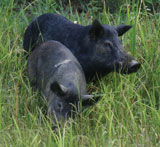
Wild Hogs: The True Story

Story and Photos by Brett Nelius
Texas is becoming a pigsty. Over two million feral hogs call this state their home, but there’s just one problem–they do not want to share the land.
Sus scrofa is the scientific name for the furry hogs that continually root up the land across the state. The hogs ruin fences, tear up landscape and even destroy crops and livestock.
Originally, these creatures were not thought of as destructive. The feral hog is actually a relative of those found in Spain, and the Spanish brought them to Texas as explorations began, accidentally releasing them into the wild. Three hundred years later, the feral hog population has grown similar to the population of Texas.
Of the 254 counties in Texas, 225 have verified reports of hog populations in their area. According to the Texas AgriLife Extension Service, of the four million estimated feral hogs in the United States, almost half are bedding down in the Lone Star state.
Some residents don’t seem to notice the hogs while others are constantly frustrated by the havoc they reek.
Lee Ueckert, a resident in Austin county, knows firsthand the problems these pigs cause.
“I try to manage parts of the land for wildlife and the other part for our cattle, and the hogs don’t care,” he said. “They will tear up the pastures, fences and feeders.”
Feral hogs prefer warm, moist areas but these tough animals have been able to adapt to areas all over the state. These areas include brush, prairie and even desert regions, making the hog very difficult to control.
One reason land owners and the state want to control the population is due to rapid herd growth. The average sow or female can begin producing offspring as early as seven months of age. According to Texas Parks and Wildlife, mature females will have up to two litters per year and some can live to be eight years old.
The greatest concern associated with these hogs is the damage they cause. State funded studies estimate annual damage by feral hogs to be close to $52 million.
“It gets old buying new fencing and even deer corn when the hogs ruin all of it,” said Ueckert.
As the numbers increase, so does the amount the state spends trying to control the population and understand how to prevent further damage. In 2006 the state of Texas spent approximately $7 million on various forms of control and educational programs to help Texans find some sort of relief.
Texans can do several things to help control the populations and reduce damage done to their property. The most expensive way to control hogs is by a process called exclusion. Exclusion involves building sound, mesh fences to keep hogs out of property and even electrifying these fences. Unfortunately, the Texas Department of Agriculture regards this as only a temporary fix.
Another method is to trap or snare hogs. Some Texans don’t want to kill the hogs on their land, so trapping is a fairly easy alternative. Trapping allows land owners to capture hogs in a natural manner. Then, they can be relocated with the help of the Texas Animal Health Commission.
The most popular way to control hog populations is hunting. Many people envision traditional hunting methods of control involving camouflage and tracking these animals, but even these methods are not enough considering the size and rapid herd growth. Land owners are now hiring crews to fly helicopters and fixed wing aircraft to hunt down and shoot many hogs at once. These methods are expensive yet effective at thinning populations in a short amount of time.
Each of these methods have pros and cons but all Texans should take into consideration that these hogs are wild, unruly animals, and people should use caution in their presence because they are dangerous.
Hogs have been known to drive hunters, farmers and ranchers up trees. The animals can range in size from a medium-sized dog to as large as a horse.
The growing concern of Texas residents has not gone unheard. The good news is, the state and its residents are working together to solve this problem as quickly as possible.